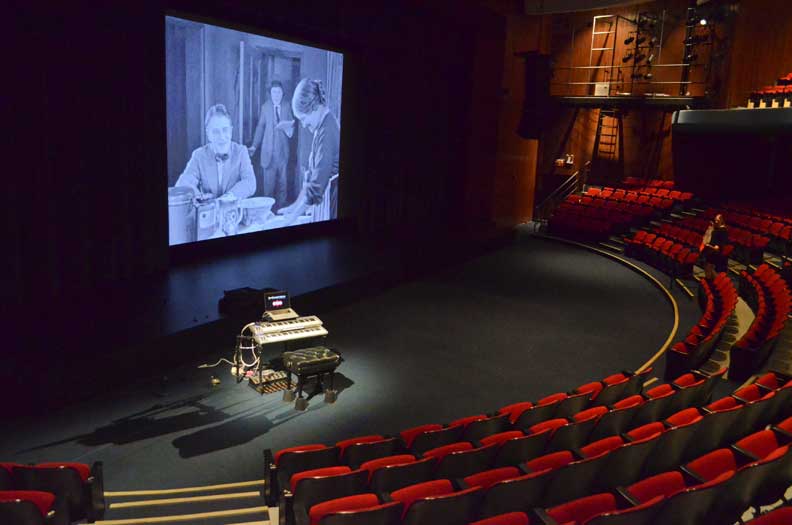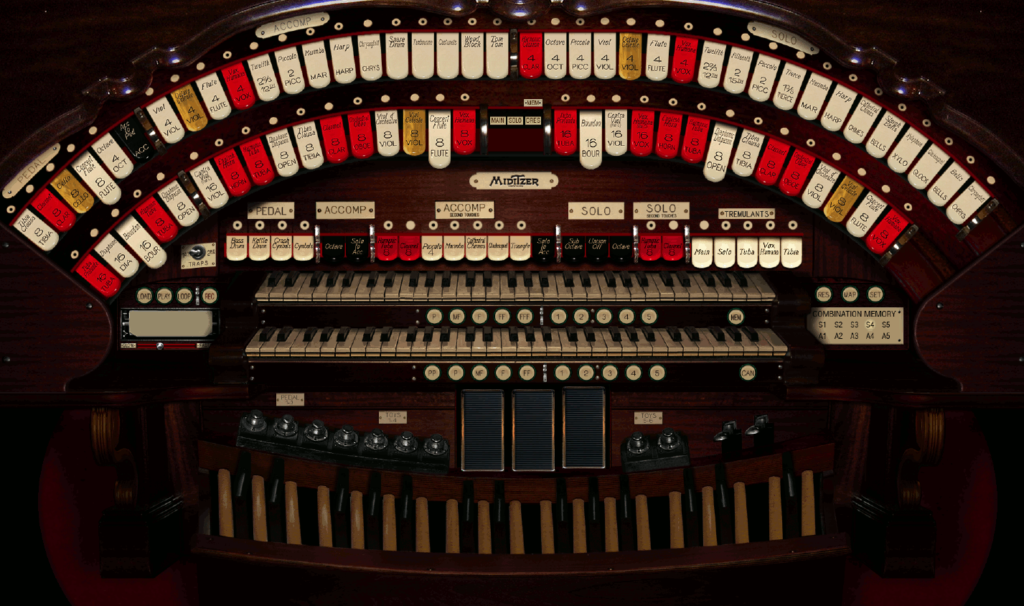When I meet people from other parts of the country and tell them I’m a silent film accompanist , they are often surprised when I tell them there are (currently) no theater organs in Manhattan. There are instruments around the west coast, several areas in the Midwest and the southeast US that get used for concerts and especially for silent film shows. But not New York City?
That is not to say there have not been efforts by the local chapter of the theatre organ society to bring theatre organ to the Big Apple. And if you go to Jersey City, NJ there is an amazing “Wonder” Morton theatre organ. But geographically, that’s Jersey, even though it’s reachable by an easy commute from Manhattan on the Path train.
Yes, there’s Radio City Music Hall…but they’re pretty busy with other stuff. The organ does get used at the Christmas show, I believe. The Wurlitzer at the Beacon is there, but the folks who own the Beacon (same ones who own RCMH) haven’t a major interest in repairing the organ and showing silent films there. The Loews 174th Street has a Wonder Morton that is undergoing a slow-and-steady rebuild.
But, pretty much since the 1986 closing of the Carnegie Hall Cinema and dribbling over another few years, silent film-goers have not heard theatre organ at Manhattan’s classic film venues. It’s basically been a piano-only town. Well, until 2006.
That was when I began using the Miditzer virtual theatre organ program for shows. I’d been contacted by Jim Henry, who created and programmed Miditzer, the year before. He’d seen what I do for silent films and read that I was working with keyboards and a MIDI organ pedal unit to do an ersatz theatre organ thing. He’d created something that was a lot closer.
Yeah, it only ran on Windows, but I found a way to deal with that. The Miditzer program had a screen display that resembled a theatre organ console, flattened to 2-D, and was interactive. You could turn stops on and off and invoke saved combinations via virtual thumb pistons with mouse-clicks or keystrokes you could assign to them. It used something called a sound font, but the sounds for each rank of “pipes” — or individual sounds like the diapason, tibia, tuba, strings et al — was pretty good. I found a USB add-on for reverb that also helped.
What’s really great about Miditzer is that it’s free and isn’t a big file or memory-taxing. It’s something you can download quickly and open and start using. Even if you don’t have a MIDI keyboard connected.
After doing my maiden voyage, my first time playing at Wesleyan in January 2006, I decided to begin using this at MoMA. Audiences at the two-month Roscoe “Fatty” Arbuckle retrospective I co-curated at MoMA in 2006 heard me use the Miditzer virtual theatre pipe organ for a majority of the shows I played. I’ve continued using the Miditzer for shows at MoMA, on and off, ever since. Until 2014 when I graduated to the Hauptwerk VTPO software and the Paramount Organ Works Wurlitzer samples. But it’s still been theatre organ.
The best thing, and one of the things that gets me past the labor of assembling and breaking down the rig at shows, is the reaction of the audience. I swear the applause after a film is heartier and maybe a little longer than it is when I accompany on piano. There is something about having that fuller, faux-symphonic sound, that enhances and improves the experience of seeing a silent film in a theater.

The rig I use is not as pretty as a real console, but it does fit into three carrying cases and a backpack and can slide into the back seat of a rented economy grade car and go anywhere I want to take it. I’ve brought the theatre organ with me to shows at the Alamo Drafthouse in Brooklyn, the Schimmel Center at Pace, Wesleyan University, the Ambler Theater, and I use it every month at the Cinema Arts Centre. I don’t always use it at MoMA, but if it’s appropriate for the film and if I’ve got a few shows in a row (less wear and tear on me) I use it.
I’m not the greatest theatre organist on the planet, and I’m the first to admit that. Also the second, and maybe also the third. I try to get better at it every year, and maybe I am. My aim was to bring the sound of the theatre organ back to the musical landscape of silent film showings in NYC. I figured I was already on the inside, so to speak, as a resident film accompanist at MoMA. I’d been playing for silents there since I got out of college, and asking the Dept. of Film if I could bring theatre organ in…worked.
Regardless of what my set-up looks like or sounds like, or what my organ technique is, the sound of the theatre organ is being included somewhere at silent film screenings in NYC on a semi-regular basis, when they’re shown. I just want to be sure that classic film fans in the city know about that wonderful majestic sound, and that it’s something they should expect to hear along with the sound of a piano.
I’ll be using my Hauptwerk + Paramount Organ Works virtual theatre organ for some shows at MoMA later in 2019 after the museum re-opens. Make sure you’re on my email list so you’ll get word about the programs once I get the okay to announce them.
To read my previous posts, check out part 1 and part 2. If you’ve enjoyed these posts, I hope you’ll consider subscribing to my blog:
[email-subscribers-form id=”1″]
